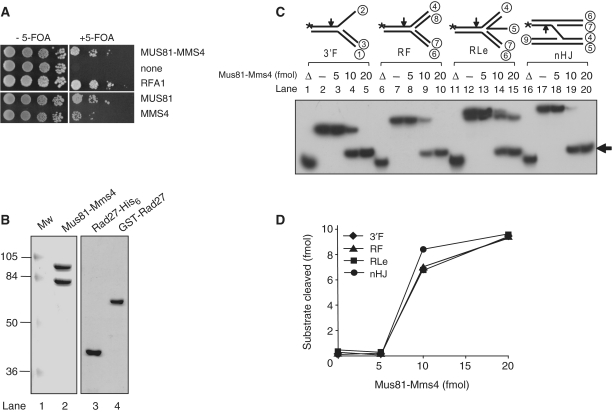Figure 1.
(A) suppression of dna2K1080E by multi-copy expression of Mus81–Mms4. The dna2Δ strain harboring pRS316-DNA2 and pRS314-dna2K1080E was transformed with pRS325-MUS81/MMS4 (MUS81–MMS4), pRS325 (Vector, vector only control), or pRS325-RFA1 (RFA1, positive control). Transformants were grown on SD-Leu-Trp-His plates. Drop-dilution assays were carried out in 10-fold serial dilutions (104, 103, 102 and 101 cells) and spotted on SD-Leu-Trp-His plates in the absence (–5-FOA) or presence (+5-FOA) of 5-fluoroorotic acid. Cells were grown at 30°C for 3 days. (B) Purification of recombinant Mus81–Mms4 and Rad27 proteins. SDS–PAGE analysis of purified Mus81–Mms4, Rad27-His6 and GST-Rad27 proteins. Mus81–Mms4 (1.6 µg, lane 2), Rad27-His6 (1.4 µg, lane 3) and GST-Rad27 (1.4 µg, lane 4) were subjected to a 10% SDS–PAGE analysis, followed by Coomassie blue staining. Mw, molecular weight marker. (C) Cleavage of four different DNA substrates by purified Mus81–Mms4. Reactions were carried out in standard reaction mixtures containing 10 fmol of each substrate as described in ‘Materials and Methods’ section. The substrates tested included 3′F, 3′ flap; RF, replication fork; RLe, regressed leading-strand replication fork; nHJ, nicked Holliday junction. The structure of each substrate is schematically illustrated at the top of the autoradiograph, and oligonucleotides used to construct the DNA substrates are indicated by encircled numbers (Table 1). Increasing amounts (5, 10 and 20 fmol) of Mus81–Mms4 were added to reaction mixtures that were incubated for 30 min at 30°C. Reactions were terminated with 0.2% SDS, 10 µg proteinase K, followed by incubation for 15 min at 37°C. The products were subjected to a 12% PAGE in 0.5× TBE at 150 V. The arrows on each substrate indicate the sites of cleavage. Asterisk indicates the position of 32P-labels at 5′ DNA ends. Open triangle indicates boiled substrate control. Minus sign indicates no enzyme control. (D) The amount (fmol) of cleavage product formed in (C) was plotted against the amounts of Mus81–Mms4 used.

